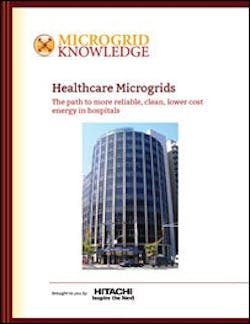Healthcare Microgrids: A Guide to More Reliable, Clean, Lower-Cost Energy for Hospitals
This is first article in a series that looks at how healthcare microgrids open the door to more reliable, clean, lower cost energy in hospitals.
Download the full report now
The senior population is on a path to double in the U.S, and even triple in Europe, according to the U.S. Census Bureau. This creates pressure to expand hospitals, healthcare networks, assisted living facilities, adult day care and nursing homes.
Add advances in medical technology, which result in new equipment that needs to be housed, and it’s easy to see why so many hospitals are constructing new wings, buildings and satellites. A survey of 3,125 hospital executives last year found that 70 percent had projects under construction or planned in the next three years.
All of this expansion means a greater need for energy — in a sector that is already highly energy intensive.
A survey of 3,125 hospital executives last year found that 70 percent had projects under construction or planned in the next three years.
Hospitals use 2.5 times as much energy as commercial buildings of the same size. This isn’t surprising given that hospitals must care for patients 24/7, which creates greater demand for lights, heat and cooling, as well as large amounts of hot water and steam for equipment sterilization, and refrigeration for temperature-sensitive medications.
For all of these reasons, energy use is a top concern for healthcare executives, especially when they look at electricity price projections that show rates rising in the coming years. The U.S. Energy Information Administration forecasts that average electricity prices will increase from 10.6 cents/kWh in 2017 to 23.5 cents/kWh in 2050.
Invisible energy loss
So what’s the best step forward, as hospitals expand, energy costs rise, and administrators feel pressure to focus more keenly on energy management?
One way is to take a careful look at existing energy infrastructure. How old is it? Often upgrades to boilers, generators, piping, metering and other equipment get put off as more pressing core needs consume a hospital’s capital budget. Aging equipment is often inefficient, adding a premium to energy costs.
A second consideration is: How well do the hospital’s energy systems work together? Are they integrated to achieve maximum efficiency? Or were they installed ad hoc as the hospital expanded its square footage? And was consideration given to how one system might influence another? Too often hospitals lack a long-term energy site plan. They may have added buildings and facilities as needed over the years to support growth of programs and services, resulting in an inefficient site energy picture.
Both of these situations can lend themselves to invisible energy inefficiencies. It may not become apparent how much money has been wasted until the hospital adds newer, more intelligent equipment, and sees the difference in usage.
“If you’re looking at physical expansion of your hospital today, you need to get your arms around energy planning,” said Steve Pullins, vice president of energy solutions at Hitachi America. “Take a look at on-site generation resources, like microgrids. You will be surprised at how valuable this proves to be.”
It may not become apparent how much money has been wasted until the hospital adds newer, more intelligent equipment, and sees the difference in usage.
In this paper, we will explain how healthcare microgrids bring intelligence and efficiency to a hospital’s energy planning. A microgrid employs a highly advanced software controller, a ‘brain,’ to optimize and synchronize the various pieces of energy equipment. Microgrids also contain more than one form of energy — often some combination of solar, energy storage and combined heat and power (CHP). The microgrid controller can determine which combination of energy resources to employ at any given time, based on hospital management goals. For example, it may optimize its energy resources to help the hospital meet budget goals, sustainability targets or other metrics.
[clickToTweet tweet=”Healthcare microgrids bring intelligence and efficiency to a hospital’s energy planning.” quote=”Healthcare microgrids bring intelligence and efficiency to a hospital’s energy planning.”]
Perhaps most important, a microgrid ensures that a hospital keeps the lights on during power outages. By now everyone has heard the dramatic stories from Superstorm Sandy — the medical personnel in darkened staircases feeling their way out to exits, trying to transport critical patients to safety. Hospitals with microgrids were spared this trauma, and in fact acted as a refuge for patients evacuated from hospitals that were not so lucky.
See video: What is a microgrid?
Guide to healthcare microgrids for medical administrators
This report will explain why hospitals are increasingly installing microgrids. We will describe a healthcare microgrid model that delivers reliable, lower cost, sustainable energy under a more predictable long- term schedule than utility power, freeing up capital so that hospitals can focus on core services. And last we will provide some real-world examples of healthcare microgrids in action.
In our next article, we’ll take a closer look at why healthcare microgrids are important to communities. Over the next few weeks we will also cover:
- More than Back-up Power: The Genius of the Healthcare Microgrid
- What Makes Healthcare Microgrids Efficient and Green?
- The No Money Down Healthcare Microgrid
- Profiles of Real World Healthcare Microgrids
For more on healthcare microgrids, see the guide “HealthCare Microgrids: The Path to More Reliable, Clean, Lower Cost Energy in Hospitals,” downloadable free of charge courtesy of Hitachi.
About the Author
Elisa Wood
Editor-in-Chief
Elisa Wood is the editor and founder of EnergyChangemakers.com. She is co-founder and former editor of Microgrid Knowledge.
